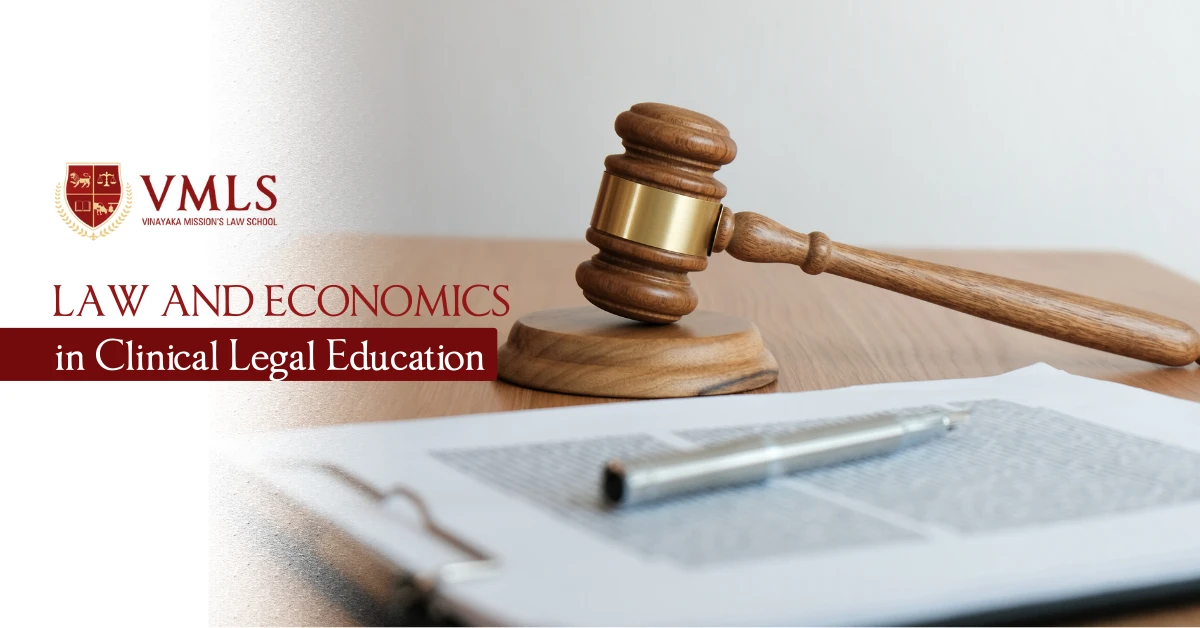June 31, 2025
0 Views

Clinical Legal Education (CLE) has become a cornerstone of professional legal training in India, particularly through the 5-Year Integrated LLB Program. Traditionally designed to bridge the gap between classroom learning and legal practice, clinics have focused on client interaction, social justice engagement, and advocacy skills. However, the integration of Law and Economics (L&E) into CLE offers an underexplored but potent pedagogical shift—one that reorients clinical activity around the logics of cost, incentives, institutional efficiency, and systemic reform.
In this article, we explore how experiential learning in law schools, particularly within the CLE framework, can be reconceptualized through the analytical tools of L&E. The shift not only enhances doctrinal understanding but equips students to interrogate legal institutions from the standpoint of efficiency, behavioral rationality, and welfare maximization.
CLE, in its current Indian avatar, includes legal aid clinics, Lok Adalat internships, prison visits, and public interest litigation (PIL) projects. These formats typically serve two goals: (1) developing practical lawyering skills, and (2) sensitizing students to socio-legal inequities.
However, when examined through an L&E lens, CLE reveals deeper pedagogical possibilities:
This approach does not detract from CLE’s social justice goals. Instead, it introduces an evidence-based, reform-driven orientation that aligns with the evolving demands of legal and policy careers.
Every clinical legal interaction—whether drafting a contract or advising a tenant in eviction proceedings—involves an implicit calculus of cost. L&E provides the vocabulary and methodology to make these calculations explicit.
In Land Rights Clinics, for instance, students can be trained to compare the efficiency of pursuing litigation versus alternate dispute resolution (ADR) routes. By mapping ex-ante (negotiation, verification) and ex-post (enforcement, appeals) transaction costs, clinics help students internalize Ronald Coase’s insight that legal outcomes are often shaped by the relative cost of resolving disputes.
Integrating behavioral law and economics into CLE allows students to design client-facing interventions that reflect bounded rationality, framing effects, and loss aversion.
In a Debt Relief Clinic, for example, rather than merely informing clients about their legal rights under the SARFAESI Act or IBC, students can frame repayment plans or restructuring options using behavioral nudges—like commitment devices, goal anchoring, or social norm messaging. Such methods can be more effective in real-world client behavior than doctrinal exposition alone.
Law and Economics also enables students to critically assess legal aid itself as a public goods problem—non-rivalrous, non-excludable, and vulnerable to under-provision. Using this frame, law students can reimagine access-to-justice interventions not just as moral imperatives, but as institutional designs in need of economic rationalization.
Policy clinics could, for instance, evaluate models of performance-based funding for legal aid services, or explore voucher systems that allow clients to choose from a menu of service providers, thereby introducing quasi-market efficiencies.
One of the core strengths of L&E is its preoccupation with institutional analysis—how rules, norms, and enforcement structures can be designed to reduce inefficiency, arbitrariness, and capture.
CLE programs can integrate modules on institutional diagnostics, where students study dysfunctional legal institutions—e.g., underperforming consumer forums, inefficient court procedures, or rent-seeking in licensing regimes—and propose data-driven, incentive-compatible redesigns.
This format not only deepens their analytical training but connects their legal learning with live issues in regulatory governance. It also aligns well with policy-oriented law school initiatives and interdisciplinary centers.
India’s 5-Year LLB Program is structurally ideal for such experimentation. By the 3rd or 4th year, students have typically acquired both doctrinal maturity and policy curiosity. Embedding CLE modules in optional L&E courses or allowing cross-listing of clinics for credit can formalize this integration.
Some suggestions include:
Law schools in India are at an inflection point. The rise of interdisciplinary education, increased demand for policy-literate lawyers, and growing interest in empirical research offer a fertile context for redesigning CLE.
By incorporating Law and Economics into experiential learning in law schools, particularly through the 5-Year LLB Program, legal education can move beyond rote case-law analysis to a more adaptive, systemic, and reform-oriented model. This shift would not only benefit students but also legal institutions and communities that interact with clinics.
In doing so, CLE becomes not just a tool for legal skill development, but a crucible for cultivating the next generation of institutional reformers, economic policymakers, and empirically grounded legal thinkers.
Several students across India are choosing law as a career due to the various benefits it offers.
The 3-year LLB (Bachelor of Legislative Law) programme is an undergraduate programme designed to cater...
Vinayak Mission's Law School (VMLS) is one of the best law schools in India and is being mentored by O. P. Jindal Global...
In India, law is seen as a noble career option, and the number of students interested in pursuing law is increasing.
If you are willing to work in a legal advisory firm, judiciary, or as a lawyer, then pursuing a law degree plays...
CLAT is a national-level entrance exam, and it stands for Common Law Entrance Test. Many top law universities in India.
Many students are developing their interest in law and several fields related to legal studies. After the 12th exam...
Many students in India choose law as a career due to the various benefits this field offers. Although there are several..